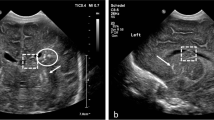Abstract
Alexander disease is a leukodystrophy caused by mutations in the GFAP gene, primarily affecting the astrocytes. This report describes the prenatal and post-mortem neuroimaging findings in a case of genetically confirmed, fetal-onset Alexander disease with pathological correlation after termination of pregnancy. The additional value of fetal brain magnetic resonance imaging in the third trimester as a complementary evaluation tool to neurosonography is shown for suspected cases of fetal-onset Alexander disease. Diffuse signal abnormalities of the periventricular white matter in association with thickening of the fornix and optic chiasm can point towards the diagnosis. Furthermore, the presence of atypical imaging findings such as microcephaly and cortical folding abnormalities in this case broadens our understanding of the phenotypic variability of Alexander disease.
Graphical Abstract



Similar content being viewed by others
References
Sosunov A, Olabarria M, Goldman JE (2018) Alexander disease: an astrocytopathy that produces a leukodystrophy. Brain Pathol 28(3):388–398. https://doi.org/10.1111/bpa.12601
Mignot C, Desguerre I, Burglen L et al (2009) Tumor-like enlargement of the optic chiasm in an infant with Alexander disease. Brain Dev 31(3):244–247. https://doi.org/10.1016/j.braindev.2008.05.005
Prust M, Wang J, Morizono H et al (2011) GFAP mutations, age at onset, and clinical subtypes in Alexander disease. Neurology 77(13):1287–1294. https://doi.org/10.1212/WNL.0b013e3182309f72
Vázquez E, Macaya A, Mayolas N, Arévalo S, Poca MA, Enríquez G (2008) Neonatal Alexander disease: MR imaging prenatal diagnosis. AJNR Am J Neuroradiol 29(10):1973–1975. https://doi.org/10.3174/ajnr.A1215
Li R, Johnson AB, Salomons G et al (2005) Glial fibrillary acidic protein mutations in infantile, juvenile, and adult forms of Alexander disease. Ann Neurol 57(3):310–326. https://doi.org/10.1002/ana.20406
Rodriguez D, Gauthier F, Bertini E et al (2001) Infantile Alexander disease: spectrum of GFAP mutations and genotype-phenotype correlation. Am J Hum Genet 69(5):1134–1140. https://doi.org/10.1086/323799
van der Knaap MS, Naidu S, Breiter SN et al (2001) Alexander disease: diagnosis with MR imaging. AJNR Am J Neuroradiol 22(3):541–552
Gowda VK, Srinivasan VM, Jetha K, Bhat MD (2019) A case of juvenile Alexander disease presenting as microcephaly. Indian J Pediatr 86(4):392–393. https://doi.org/10.1007/s12098-018-02850-y
Paladine D, Malinger G, Birnbaum R et al (2021) ISUOG Practice Guidelines (updated): sonographic examination of the fetal central nervous system. Part 2: performance of targeted neurosonography. Ultrasound Obstet Gynecol 57:661–671. https://doi.org/10.1002/uog.23616
Author information
Authors and Affiliations
Contributions
M.A. and J.D. contributed to the conception and design of the case report. J.R. and K.J. interpreted the images of the fetal (neuro-)sonography. J.D. and M.A. interpreted the magnetic resonance images. D.R.T. and M.B. performed the autopsy and analysis of the histopathological specimens. K.D. performed the genetical analysis. The first draft of the manuscript was written by J.D. and all the authors commented on subsequent versions of the manuscript. All authors read and approved the final manuscript.
Corresponding author
Ethics declarations
Conflicts of interest
D.R.T. received speaker honorary from Novartis Pharma AG (Switzerland) and Biogen (USA) and travel reimbursement from GE-Healthcare (UK) and UCB (Belgium) and collaborated with Novartis Pharma AG (Switzerland), Probiodrug (Germany), GE-Healthcare (UK) and Janssen Pharmaceutical Companies (Belgium). D.R.T. receives grants from Fonds Wetenschappelijk Onderzoek (FWO (Vlaanderen): G0F8516N, G065721N), Stichting Alzheimer Onderzoek (SAO-FRA (Belgium): 2020/017) and KU-Leuven Internal Funding (C14/22/132; C3/20/057).
Additional information
Publisher's note
Springer Nature remains neutral with regard to jurisdictional claims in published maps and institutional affiliations.
Dietmar R. Thal and Michael Aertsen contributed equally to the manuscript as senior authors.
Supplementary information
Below is the link to the electronic supplementary material.
Rights and permissions
Springer Nature or its licensor (e.g. a society or other partner) holds exclusive rights to this article under a publishing agreement with the author(s) or other rightsholder(s); author self-archiving of the accepted manuscript version of this article is solely governed by the terms of such publishing agreement and applicable law.
About this article
Cite this article
Devos, J., Devriendt, K., Richter, J. et al. Fetal-onset Alexander disease with radiological-neuropathological correlation. Pediatr Radiol 53, 2149–2153 (2023). https://doi.org/10.1007/s00247-023-05710-w
Received:
Revised:
Accepted:
Published:
Issue Date:
DOI: https://doi.org/10.1007/s00247-023-05710-w




